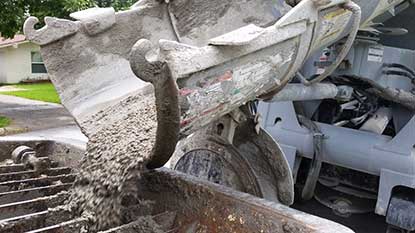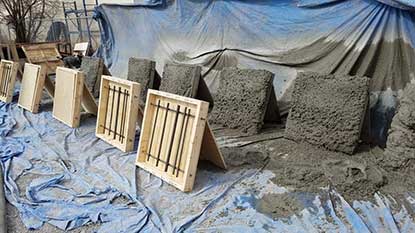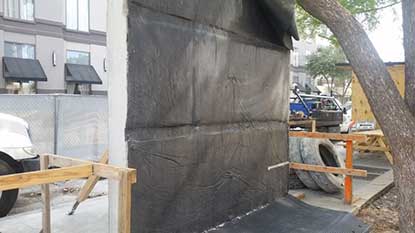SHOTCRETE SPECIFICATIONS
Shotcrete Specifications and Resources for Your Project Documentation
CONTACT CCP TO INCORPORATE SHOTCRETE SPECIFICATIONS
Shotcrete is an industry accepted and adopted method of concrete construction. CCP is a qualified shotcrete contractor. Our project managers are standing by to help incorporate shotcrete specifications into your project documentation. In the meantime, feel free to browse through a few of the most requested shotcrete resources and specifications.
SPECIFICATIONS FOR SHOTCRETE
Preparation of the receiving surface generally consists of the removing of unsound material, roughening and dampening to a saturated surface-dry (SSD) condition just before shotcrete placement. This section also covers the specification for lap splicing of reinforcement. When approved by an architect, non contact lap splicing assists the encapsulation of concrete during shotcrete operations – particularly useful for large diameter and congested reinforcement.
Temporary coverings can be erected to protect adjacent areas from overspray. A work surface that provides unobstructed access to the receiving surface allows a shotcrete nozzleman and crew to maximize production. Shotcrete nozzleman techniques, encasement of reinforcement, and hot and cold weather shotcreting are all addressed in this section.
Shotcrete curing methods include the ponding or continuous sprinkling for a minimum of 7 days, covering with continuously wet absorptive mats, approved curing blankets or the application of curing compounds applied at twice the manufacturer’s rate if the surface is left to a gun finish. Often a shotcrete application will determine which curing method(s) are feasible.
This section covers the two types of jointing during the shotcrete process – construction joints and contraction joints. Shotcrete placed in multiple layers does not create cold joints. Unless otherwise specified by the project engineer stop forms (bulk heads) are not required at the end of each day’s shotcrete operations. Tooled-in contraction joints are made during the course of shotcrete work while concrete is still “green”.
This section of the Guide to Shotcrete reviews in detail the positions within a professional shotcrete crew. ACI Certified Shotcrete Nozzlemen, blow pipe operators, concrete line pump operators, cutters and finishers, laborers, a foreman and superintendent are all necessary positions during the course of work. Crew qualifications are outlined as are communication methods.
Alignment control is necessary to establish line and grade in shotcrete construction. Reinforcement curtains and cages are to be secured anchored to the substrate. Protrusions through waterproofing sheet membranes need to be patched. Piano (ground) wires are installed to establish wall thickness.
Performance-based specifications (PBS) should be used whenever possible. Contrary to a prescribed specification PBS allows the contractor to submit a concrete mix that achieves a specifier’s required performance characteristics. CCP has developed high performing shotcrete mixes with years of proven test results.
Shotcrete can provide a variety of high quality finishes. For primary liners, temporary shoring or for walls not intended to be visible as part of the final product a natural / gun / nozzle finish is the most economical to implement. CCP regularly finishes shotcrete projects with wood floats, rubber floats, brush and even a steel trowel to create a Class A finish. Architectural requirements and tolerances determine which finish(es) to perform during shotcrete operations.
GUIDE TO SHOTCRETE
Shotcrete Resources
Guide Specification for Structural Shotcrete Walls
A great resource for shotcrete specifiers, General Contractors and Project Managers who plan to incorporate structural shotcrete walls. A full range of topics include suitable shotcrete equipment, crew qualifications, quality assurance, shotcrete application and inspection.
Culvert Rehabilitation Guidance
This guide by MaineDOT covers culvert repair options including shotcrete. Topics include culvert analysis, pros and cons of liner options, repair preparations, concrete proportioning, shotcrete requirements and environmental considerations.
Shotcrete Placed in Multiple Layers does NOT Create Cold Joints
When a receiving surface is properly prepared and brought to a saturated surface dry (SSD) condition, shotcrete may be applied in multiple layers without creating any cold joints.
Shotcrete — The Blindside Waterproofing Solution
Calling all engineers and shotcrete specifiers. Make sure your project calls for a blindside waterproofing solution suitable for the shotcrete process. There are several tried-and-true options available on the market.
Gunite Versus Shotcrete in Swimming Pool Construction
What’s better – dry mix (“gunite”) or wet mix shotcrete? The answer depends on the application, production goals and site considerations just to name a few factors.
Form-and-Pour to Shotcrete
Structural shotcrete placement offers many advantages over the form-and-pour methodology. The article includes a brief history of shotcrete for structural applications and discusses its advantages including a reduction in formwork, labor and schedule savings, and a reduced environmental impact.



